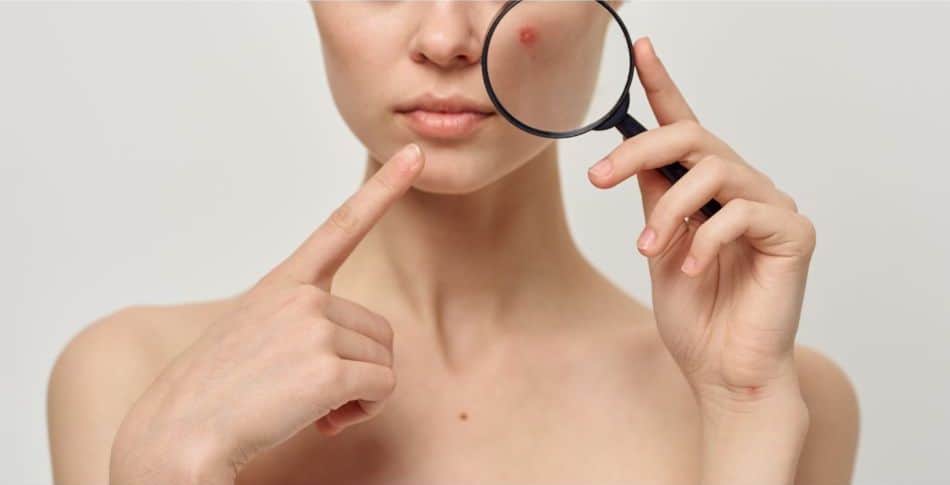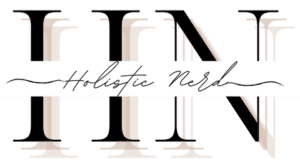
Acne vulgaris is one of the most prevalent skin disorders in the world affecting not only adolescents but a high percentage of adults, too. There are several different types of acne and some of them can be caused by other underlying health conditions, such as PCOS (Polycystic Ovarian Syndrome).
Recognizing the type and origin of your acne is therefore extremely important as it can help address the root cause of other health issues. If you’re not sure how to tell the difference between PCOS acne and regular breakouts, I’m here to give you some guidance and answer all your questions.
In this article, I’ll explain all you need to know about different types of breakouts, how to identify a PCOS acne pattern and how to successfully clear your skin. As someone who’s experienced all types of acne in all stages of life (find out more about it here: ‘How I Cured My PCOS Acne Naturally‘) I know particularly well how to distinguish between regular breakouts, skin reactions and PCOS acne.
However, bear in mind that acne, in general, is a complex condition that’s not sufficiently researched and completely understood. It is also extremely individual which is why I always recommend working with a professional and a personalized approach. That being said, here are some general key points you should know about acne.
What is acne?
Skin breakouts typically occur when your hair follicles get clogged by excess oil, dead skin or bacteria resulting in different types of pimples. There are many different factors that can affect the type, prevalence and severity of your breakouts but some of the most common ones include:
- Genetics (family history of acne)
- Hormonal changes (pregnancy, puberty, stress)
- Personal products (skincare products, makeup)
- Medications (birth control pills, corticosteroids)
- Hygiene (sweat, undercleansing, dirty hands)
- Fungus (yeast overgrowth)
- Diet (food reactions)
Occasional breakouts (clogged pores) are considered to be a mild form of acne but you can develop moderate (inflamed breakouts) or even severe (painful lumps) forms of this skin condition. Here’s a list of the most common types of pimples in the order of their severity (from low to high).
Types of pimples:
- Whiteheads (plugged pores/closed)
- Blackheads (plugged pores/open)
- Papules (red/tender)
- Pustules (papules with pus)
- Nodules (underskin lumps/painful)
- Cysts (underskin lumps with pus/painful)
PCOS-induced Acne
Although PCOS acne can’t be fully determined by the type of pimples appearing on your skin, it is typically associated with a higher prevalence of nodules and cysts deep underneath the skin. These types of breakouts can be particularly painful, red, inflamed and almost impossible to heal.
They also tend to appear mainly in the androgen-sensitive parts of the face and body (where men would typically grow facial/body hair) which is usually a sign of some underlying hormonal issues.
Here are some other common indicators of PCOS-related acne.
PCOS acne pattern:
- Deeply rooted breakouts (large, red, painful)
- The lower part of the face (jawline, chin, neck)
- Other parts of the body (chest, upper back)
- Prolonged healing period (increased risk of scarring)
- Inflammation (redness, swelling, blemishes)
- Increased sebum production (oily skin)
- Persistent till adulthood (over the age of 25)
PCOS acne vs. regular acne
The biggest difference between PCOS-induced acne and regular breakouts is that in the case of PCOS, the root cause of problematic skin is hormone related. While some conventional topical acne treatments can help improve mild breakouts, the only way to clear PCOS acne completely is to address and treat the underlying hormonal imbalances.
The main causes of PCOS acne are:
- High levels of androgens (the ‘male’ hormones responsible for increased oil production)
- Low levels of progesterone & estradiol (the ‘female’ hormones important for the skin’s healing process)
- Insulin resistance (high levels of insulin triggering ovaries to produce more androgens)
- Chronic inflammation (contributing to insulin resistance and inflamed breakouts)
- Chronic stress (triggering adrenals to produce more androgens)
How to manage PCOS acne
Despite the fact that PCOS is a long-life chronic condition that can’t be fully cured, there are many effective ways to successfully restore hormonal balance and live a PCOS symptoms-free life. This means that with appropriate lifestyle changes, you can fully reverse your PCOS-induced acne and completely clear your skin.
I’ve created a complete guide on how to do that which you can access here: ‘PCOS Acne Explained & How To Treat It Naturally‘ but here is a quick summary of some of the most important steps.
- Understanding the root cause (hyperandrogenism, inflammation, insulin resistance, stress)
- Making dietary changes (anti-inflammatory, low GI, dairy-free, nutrient-rich whole foods)
- Exercising regularly (all types of exercise)
- Improving sleep hygiene (quantity & quality)
- Managing stress (on a daily basis)
- Taking dietary supplements (tailored to personal needs)
- Avoiding environmental toxins (EDCs, pesticides, plastics)
- Quitting smoking (all nicotine-containing products)
- Using appropriate skincare (EDC-free, natural, non-comedogenic)
- Knowing the triggers (foods, skincare, lifestyle)
Read more: ‘The Best PCOS Diet (Ultimate Guide)’
If you feel that PCOS might be the root cause of your acne it is crucial to work with a healthcare professional and get your hormone levels tested (as well as other important health metrics). There are many possible causes of acne and PCOS is only one of them. Getting the right diagnosis is therefore the best first step in resolving this issue and healing your skin.
To be diagnosed with PCOS (according to the Rotterdam criteria) you need to have at least 2 of the following symptoms: hyperandrogenism (high levels of androgens), irregular periods, and polycystic ovaries. However, other typical features of PCOS include: weight gain, belly fat, hirsutism (facial & body hair), acne, hair loss and insulin resistance.
Read more:
- ‘The Best Skincare Products For PCOS & Hormonal Acne‘
- ‘The Best Makeup Products For PCOS & Hormonal Acne‘
Pro tips:
- Get tested – get your hormones and other important health metrics tested regularly so you can better understand your condition, find appropriate treatment strategies and track your progress
- Work with a professional – PCOS is a complex condition that can become very overwhelming so having access to the right information, tests and moral support can be a life-changer in your journey
- Be patient – keep in mind that our endocrine system is very complex and once you introduce new treatment strategies, it usually takes a minimum of 3-6 months before you start seeing some results (especially when healing your skin)
- Keep a diary – a skin diary is a great tool that can help you identify potential triggers in your skincare/diet/lifestyle so you can better understand your individual needs and choose accordingly
- Change pillowcases – make sure you change your pillowcases frequently to prevent spreading bacteria on your skin, your pillow is one of the most bacteria-friendly places as it’s usually covered in sweat, oils, dirt and dead skin
- Don’t touch your face – perhaps the most difficult but the most important thing is not touching and picking your face, but it really stops bacteria from spreading and helps prevent infection and scarring
- Clean your phone – your phone is another common home for various bacteria that can easily spread onto your skin, make sure you clean it frequently and try not to hold it close to your face when on the phone
- Use clean face towels – use separate towels for your face and change them frequently, you can get 7 mini towels (1 for each day) for your face and wash them all once a week
- Clean your make-up brushes – keep your make-up brushes clean and make sure you wash them frequently since it’s something you put directly on your face every day
- Exfoliate gently – exfoliating is important for removing dead skin cells and cleaning your pores but you shouldn’t overdo it or be too aggressive as it can irritate your skin and lead to even worse acne (exfoliate 1-2x per week very gently)
- Moisturize – don’t skip the moisturizing step as keeping your skin hydrated is extremely important for healing acne and preventing scarring (you can find my favorite moisturizers here: ‘5 Best Moisturizers For PCOS Acne‘)
- Double cleanse – always double cleanse your skin (especially in the evening) to remove all bits of makeup, dirt, oils and bacteria that could clog your pores and trigger new breakouts (you can find my favorite cleansers here: ‘5 Best Face Washes For PCOS Acne‘)
Resources:
- Archer, J. S., & Chang, R. J. (2004). Hirsutism and acne in polycystic ovary syndrome. Best practice & research. Clinical obstetrics & gynaecology, 18(5), 737–754. https://doi.org/10.1016/j.bpobgyn.2004.05.007
- Gainder, S., & Sharma, B. (2019). Update on Management of Polycystic Ovarian Syndrome for Dermatologists. Indian dermatology online journal, 10(2), 97–105. https://doi.org/10.4103/idoj.IDOJ_249_17
- González-Saldivar, G., Rodríguez-Gutiérrez, R., Ocampo-Candiani, J., González-González, J. G., & Gómez-Flores, M. (2017). Skin Manifestations of Insulin Resistance: From a Biochemical Stance to a Clinical Diagnosis and Management. Dermatology and therapy, 7(1), 37–51. https://doi.org/10.1007/s13555-016-0160-3
- Housman, E., & Reynolds, R. V. (2014). Polycystic ovary syndrome: a review for dermatologists: Part I. Diagnosis and manifestations. Journal of the American Academy of Dermatology, 71(5), 847.e1–858. https://doi.org/10.1016/j.jaad.2014.05.007
- Ju, Q., Tao, T., Hu, T., Karadağ, A. S., Al-Khuzaei, S., & Chen, W. (2017). Sex hormones and acne. Clinics in dermatology, 35(2), 130–137. https://doi.org/10.1016/j.clindermatol.2016.10.004
- Keen, M. A., Shah, I. H., & Sheikh, G. (2017). Cutaneous Manifestations of Polycystic Ovary Syndrome: A Cross-Sectional Clinical Study. Indian dermatology online journal, 8(2), 104–110. https://doi.org/10.4103/2229-5178.202275
- Kucharska, A., Szmurło, A., & Sińska, B. (2016). Significance of diet in treated and untreated acne vulgaris. Postepy dermatologii i alergologii, 33(2), 81–86. https://doi.org/10.5114/ada.2016.59146
- Lause, M., Kamboj, A., & Fernandez Faith, E. (2017). Dermatologic manifestations of endocrine disorders. Translational pediatrics, 6(4), 300–312. https://doi.org/10.21037/tp.2017.09.08
- Moran, L. J., Hutchison, S. K., Norman, R. J., & Teede, H. J. (2011). Lifestyle changes in women with polycystic ovary syndrome. The Cochrane database of systematic reviews, (2), CD007506. https://doi.org/10.1002/14651858.CD007506.pub2
- Ramezani Tehrani, F., Behboudi-Gandevani, S., Bidhendi Yarandi, R., Saei Ghare Naz, M., & Carmina, E. (2021). Prevalence of acne vulgaris among women with polycystic ovary syndrome: a systemic review and meta-analysis. Gynecological endocrinology : the official journal of the International Society of Gynecological Endocrinology, 37(5), 392–405. https://doi.org/10.1080/09513590.2020.1859474
